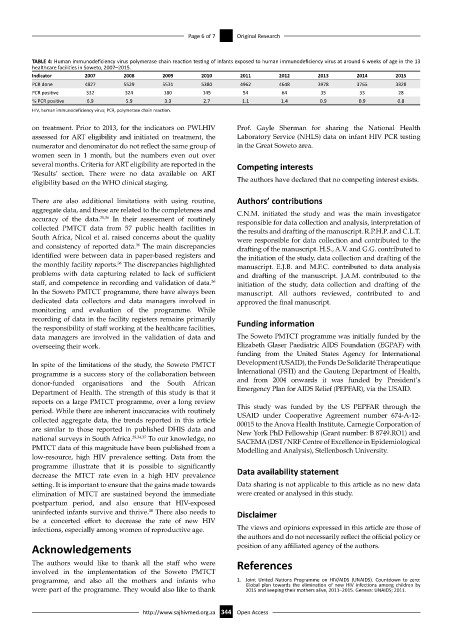Page 352 - HIVMED_v21_i1.indb
P. 352
Page 6 of 7 Original Research
TABLE 4: Human immunodeficiency virus polymerase chain reaction testing of infants exposed to human immunodeficiency virus at around 6 weeks of age in the 13
healthcare facilities in Soweto, 2007–2015.
Indicator 2007 2008 2009 2010 2011 2012 2013 2014 2015
PCR done 4827 5529 5531 5380 4962 4648 3978 3765 3328
PCR positive 332 324 180 145 54 64 35 33 28
% PCR positive 6.9 5.9 3.3 2.7 1.1 1.4 0.9 0.9 0.8
HIV, human immunodeficiency virus; PCR, polymerase chain reaction.
on treatment. Prior to 2013, for the indicators on PWLHIV Prof. Gayle Sherman for sharing the National Health
assessed for ART eligibility and initiated on treatment, the Laboratory Service (NHLS) data on infant HIV PCR testing
numerator and denominator do not reflect the same group of in the Great Soweto area.
women seen in 1 month, but the numbers even out over
several months. Criteria for ART eligibility are reported in the Competing interests
‘Results’ section. There were no data available on ART
eligibility based on the WHO clinical staging. The authors have declared that no competing interest exists.
There are also additional limitations with using routine, Authors’ contributions
aggregate data, and these are related to the completeness and C.N.M. initiated the study and was the main investigator
accuracy of the data. 35,36 In their assessment of routinely responsible for data collection and analysis, interpretation of
collected PMTCT data from 57 public health facilities in the results and drafting of the manuscript. R.P.H.P. and C.L.T.
South Africa, Nicol et al. raised concerns about the quality were responsible for data collection and contributed to the
and consistency of reported data. The main discrepancies drafting of the manuscript. H.S., A.V. and G.G. contributed to
36
identified were between data in paper-based registers and the initiation of the study, data collection and drafting of the
the monthly facility reports. The discrepancies highlighted manuscript. E.J.B. and M.F.C. contributed to data analysis
36
problems with data capturing related to lack of sufficient and drafting of the manuscript. J.A.M. contributed to the
36
staff, and competence in recording and validation of data. initiation of the study, data collection and drafting of the
In the Soweto PMTCT programme, there have always been manuscript. All authors reviewed, contributed to and
dedicated data collectors and data managers involved in approved the final manuscript.
monitoring and evaluation of the programme. While
recording of data in the facility registers remains primarily Funding information
the responsibility of staff working at the healthcare facilities,
data managers are involved in the validation of data and The Soweto PMTCT programme was initially funded by the
overseeing their work. Elizabeth Glaser Paediatric AIDS Foundation (EGPAF) with
funding from the United States Agency for International
In spite of the limitations of the study, the Soweto PMTCT Development (USAID), the Fonds De Solidarité Thérapeutique
programme is a success story of the collaboration between International (FSTI) and the Gauteng Department of Health,
donor-funded organisations and the South African and from 2004 onwards it was funded by President’s
Department of Health. The strength of this study is that it Emergency Plan for AIDS Relief (PEPFAR), via the USAID.
reports on a large PMTCT programme, over a long review This study was funded by the US PEPFAR through the
period. While there are inherent inaccuracies with routinely USAID under Cooperative Agreement number 674-A-12-
collected aggregate data, the trends reported in this article 00015 to the Anova Health Institute, Carnegie Corporation of
are similar to those reported in published DHIS data and New York PhD Fellowship (Grant number: B 8749.RO1) and
national surveys in South Africa. 29,34,37 To our knowledge, no SACEMA (DST/NRF Centre of Excellence in Epidemiological
PMTCT data of this magnitude have been published from a Modelling and Analysis), Stellenbosch University.
low-resource, high HIV prevalence setting. Data from the
programme illustrate that it is possible to significantly Data availability statement
decrease the MTCT rate even in a high HIV prevalence
setting. It is important to ensure that the gains made towards Data sharing is not applicable to this article as no new data
elimination of MTCT are sustained beyond the immediate were created or analysed in this study.
postpartum period, and also ensure that HIV-exposed
38
uninfected infants survive and thrive. There also needs to Disclaimer
be a concerted effort to decrease the rate of new HIV
infections, especially among women of reproductive age. The views and opinions expressed in this article are those of
the authors and do not necessarily reflect the official policy or
Acknowledgements position of any affiliated agency of the authors.
The authors would like to thank all the staff who were References
involved in the implementation of the Soweto PMTCT
programme, and also all the mothers and infants who 1. Joint United Nations Programme on HIV/AIDS (UNAIDS). Countdown to zero:
were part of the programme. They would also like to thank Global plan towards the elimination of new HIV infections among children by
2015 and keeping their mothers alive, 2011–2015. Geneva: UNAIDS; 2011.
http://www.sajhivmed.org.za 344 Open Access

